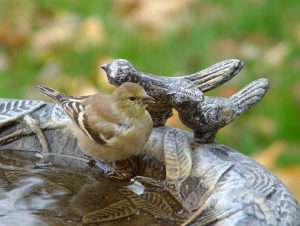
Bird Baths
To increase bird diversity in your backyard, enhance your property by adding a water source, a roost box (try building your own!), or a supply of nest material. As well as improving life for your local feeder birds, you’ll increase the chances that species that normally don’t visit feeders will set up home nearby.
Birdbaths
 Trying to make your backyard more attractive to birds? Just add water! Birds need a dependable supply of fresh, clean water for drinking and bathing—few things are more attractive to them than a well-maintained birdbath. In fact, a birdbath in your yard may attract birds that don’t eat seeds and wouldn’t otherwise come to your feeders.
Trying to make your backyard more attractive to birds? Just add water! Birds need a dependable supply of fresh, clean water for drinking and bathing—few things are more attractive to them than a well-maintained birdbath. In fact, a birdbath in your yard may attract birds that don’t eat seeds and wouldn’t otherwise come to your feeders.
Traditional concrete birdbaths aren’t the best type for birds—they’re often too deep, glazed ones may be too slippery, and they’re often hard to clean. Also, they may crack when the temperature drops below freezing. The best birdbaths mimic nature’s birdbaths—puddles and shallow pools of water in slow streams; they’re shallow with a gentle slope so birds can wade into the water.
You can make your own birdbath using a trashcan lid, saucer-type snow sled, shallow pan, or old frying pan.
Setting up your birdbath
Birds seem to prefer baths that are set at ground level, where they typically find water in nature. While birds are bathing, they are sometimes less wary than is safe, and if their feathers get soaked, they can’t take off or fly as quickly as normal, so cats pose a very serious danger. If cats are at all likely to be lurking in your neighborhood, make sure there is a fairly wide open area between your birdbath and the nearest thick shrubbery, so birds have a better chance to detect and get away from a pouncing cat in time.
Place your birdbath in the shade if possible, to keep the water cooler and fresher. Nearby trees also provide branches on which they can preen.
Clean sand or gravel on the bottom will provide more secure footing. Arrange a few branches or stones in the water so birds can stand on them to drink without getting wet (this is particularly important during freezing weather).
The water should be no deeper than 1/2 to 1 inch at the edges, sloping to a maximum of 2 inches deep in the middle of the bath.
One of the best ways to make your birdbath even more attractive is to provide dripping water. Many birds find the sight and sound of moving water irresistible. You can use a commercial dripper or sprayer, or make your own by recycling an old bucket or plastic container. Punch a tiny hole in the bottom, fill it with water, and hang it above the birdbath so the water drips into the bath.
Winter birdbaths
Drinking water entices birds year-round, but keeping it ice free in winter is not as critical as many people believe. Birds have several physiological mechanisms for conserving water, and can usually get plenty from snow or dripping icicles. Electrical birdbath heaters may not be justifiable in light of the problems birds face from electricity production; also, if the air temperature is cold enough to make the water steam, heated birdbaths may pose an immediate danger to birds. On freezing days, birds should use baths for drinking only—not bathing. A network of sticks over a birdbath, holding birds above the water and make bathing uncomfortable, should prevent problems.
The simplest and probably the safest and most environmentally conscientious way to provide water in winter is to set out a plastic bowl at the same time each day, and bring it in when ice forms.
If you do want to keep a birdbath ice-free during sub-freezing days, you have several choices. Manufacturers now offer birdbaths with built-in, thermostatically controlled heaters. Immersion heaters are also available. Most new models turn off if the water in the bath dries up.
Never add antifreeze to the birdbath—it is poisonous to all animals, including birds. Some people use glycerin as a makeshift antifreeze in birdbaths, but it is not recommended. Glycerin is a low-level toxin—if birds drink too much, it raises their blood sugar so much that they may die. Furthermore, when birds bathe in glycerin-spiked water, their feathers can become saturated and matted, providing poor insulation and leaving them susceptible to hypothermia.
Maintaining your birdbath
When the temperature is above freezing, it’s a good idea to keep your birdbath full at all times to attract the widest numbers and variety of birds. But to provide a safe drinking and bathing environment, it’s critical to change the water every day or two. Bathing birds may leave behind dirty feathers and droppings, making the bath increasingly unsanitary for other birds. Grackles often drop their nestlings’ fecal sacs into birdbaths, another cause of filthy water. Algae grows much more quickly when the water isn’t cleaned frequently. Also, the species of mosquitoes most likely to transmit West Nile virus often lay their eggs in bird baths. By frequently changing the water, we don’t give the eggs time to hatch or for the larvae to emerge.
If algae does start to grow, you should thoroughly clean the bath with a stiff scrub brush and running water.